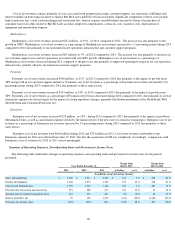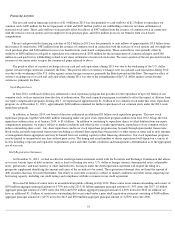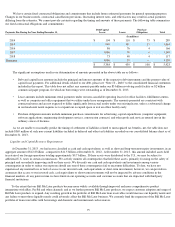eBay 2013 Annual Report Download - page 81
Download and view the complete annual report
Please find page 81 of the 2013 eBay annual report below. You can navigate through the pages in the report by either clicking on the pages listed below, or by using the keyword search tool below to find specific information within the annual report.
From time to time, we engage in certain intercompany transactions and legal entity restructurings. We consider many factors when
evaluating these transactions, including the alignment of our corporate structure with our organizational objectives and the operational and tax
efficiency of our corporate structure, as well as the long-term cash flows and cash needs of our different businesses. These transactions may
impact our overall tax rate and/or result in additional cash tax payments. The impact in any period may be significant. These transactions may be
complex and the impact of such transactions on future periods may be difficult to estimate.
We believe that our existing cash, cash equivalents, short-term and long-term investments, together with cash expected to be generated
from operations, borrowings available under our credit agreement and commercial paper program, and our access to capital markets will be
sufficient to fund our operating activities, anticipated capital expenditures, Bill Me Later portfolio of loan receivables and stock repurchases for
the foreseeable future.
Off-Balance Sheet Arrangements
As of December 31, 2013 , we had no off-balance sheet arrangements that have, or are reasonably likely to have, a current or future
material effect on our consolidated financial condition, results of operations, liquidity, capital expenditures or capital resources.
In Europe, we have two cash pooling arrangements with a financial institution for cash management purposes. These arrangements allow
for cash withdrawals from this financial institution based upon our aggregate operating cash balances held in Europe within the same financial
institution (“Aggregate Cash Deposits”). These arrangements also allow us to withdraw amounts exceeding the Aggregate Cash Deposits up to
an agreed-upon limit. The net balance of the withdrawals and the Aggregate Cash Deposits are used by the financial institution as a basis for
calculating our net interest expense or income. As of December 31, 2013 , we had a total of $3.1 billion in cash withdrawals offsetting our $3.1
billion in Aggregate Cash Deposits held within the same financial institution under these cash pooling arrangements.
Based on differences in regulatory requirements and commercial law in the jurisdictions where PayPal operates, PayPal holds customer
balances either as direct claims against PayPal or as an agent or custodian on behalf of PayPal's customers. Customer balances held by PayPal as
an agent or custodian on behalf of our customers are not reflected on our consolidated balance sheet, while customer balances held as direct
claims against PayPal are reflected on our consolidated balance sheet.
In 2012, PayPal's California regulator, the Division of Financial Institutions under the California Department of Business Oversight,
notified PayPal that PayPal's practice of holding the funds underlying U.S. customer balances as an agent on behalf of its customers, rather than
as owner of those funds, meant that PayPal could not treat those funds as liquid assets for purposes of the liquidity rules applicable to California
money transmitter licensees. Based on changes to our U.S. PayPal user agreement effective November 1, 2012, PayPal began holding U.S.
customer balances as direct claims against PayPal, rather than as an agent or custodian on behalf of such PayPal customers. As a result, effective
November 1, 2012, all U.S. PayPal customer balances, which were previously not reflected on our consolidated balance sheet, have been
reflected as assets in our consolidated balance sheet under “Funds receivable and customer accounts,” with an associated liability under “Funds
payable and amounts due to customers.” Following this change, PayPal now holds all customer balances (both in the U.S. and internationally) as
direct claims against PayPal.
Indemnification Provisions
In the ordinary course of business, we have included limited indemnification provisions in certain of our agreements with parties with
which we have commercial relations, including our standard marketing, promotions and application-programming-interface license agreements.
Under these contracts, we generally indemnify, hold harmless and agree to reimburse the indemnified party for losses suffered or incurred by the
indemnified party in connection with claims by a third party with respect to our domain names, trademarks, logos and other branding elements to
the extent that such marks are applicable to our performance under the subject agreement. In certain cases we have agreed to provide
indemnification for intellectual property infringement. Our Enterprise business has provided in many of its major ecommerce agreements an
indemnity for other types of third-party claims, which are indemnities mainly related to various intellectual property rights, and we have
provided similar indemnities in a limited number of agreements for our other businesses. In our PayPal business, we have provided an indemnity
to our payment processors in the event of certain third-party claims or card association fines against the processor arising out of conduct by
PayPal or PayPal customers. PayPal has also provided a limited indemnity to merchants using its retail point of sale payment services and to
manufacturers of its point of sale devices (e.g., the PayPal Here devices and the Beacon device). In addition, Bill Me Later has provided
indemnification provisions in its agreements with the chartered financial institutions that issue its credit products. It is not possible to determine
the maximum potential loss under these
76
























